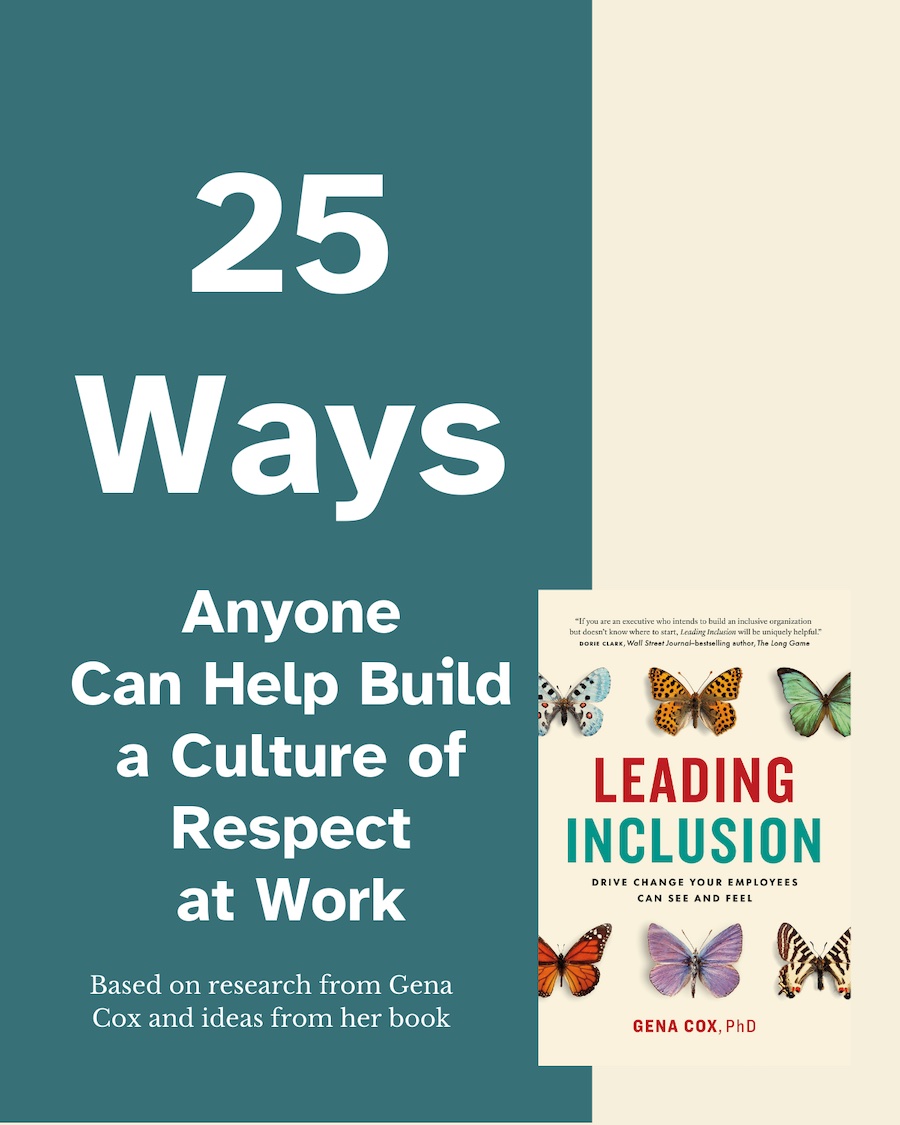The Business Case for Diversity Does Not Work: Here’s Why

Business leaders often ask, “what is the business case for workplace diversity?” But, is that the right question to ask when discussing the human experience in the workplace? The business case model works well when making mundane decisions like “should we upgrade the computer monitors?” But, this approach seems uncaring when used as a primary criterion for addressing the diversity and inclusion (D&I) challenge in the workplace. It is true that business outcomes are negatively impacted when diversity and inclusion are deficient, but it is the psychological and emotional trauma to disadvantaged employees that really deserves the focus. It’s time to try a more human-centered approach.
“The business case” is the go-to approach for Diversity & Inclusion
The business case for diversity is a methodology often employed to convince senior organization leaders to enhance the diversity of their workforce and the inclusiveness of their organization cultures. The business case approach seeks to answer the question, “What are the positive impacts on long-term business growth, profitability, or other business outcomes, that warrant paying attention to the D&I issue?” This approach seeks to create an air-tight case so executives can get the backing of their boards to support the effort. Many leaders indicate they cannot begin efforts to make their workplaces better for ALL employees, until their board believes these efforts are cost-effective.
Diversity is good for business. Case closed.
In the years this business case approach has been championed, both business practitioners and researchers have done all they can to document the benefits businesses derive from workforce diversification. The conclusions are clear. Diversity offers a variety of benefits, regardless of the dimension of difference being analyzed. In an American Sociological Review article published in 2009, Cedric Herring found support for the value-in-diversity hypothesis. He wrote, “racial diversity is associated with increased sales revenue, more customers, greater market share, and greater relative profits.” Gender diversity, he found, is associated with increased sales revenue, more customers, and greater relative profits. Similar positive outcomes are derived from neurodiverse and LGBTQ-supportive workplaces.
The known positive outcomes of workplace diversity have not mattered
It has been unequivocally proven that diversity in the workplace has a positive effect on valued business outcomes, including profits, innovation and decision-making. Corporate board performance is also enhanced by diversity.
Nevertheless, that proven “business case for diversity” has not resulted in a rush to demographic diversification in corporations. One of the most persistent race-based disparities can be seen in the experience of Black Americans at work. According to the 2019 Bureau of Labor Force Statistics, Black Americans make up 13.4% of the U.S. population, but are over-represented in lower-paying jobs and under-represented in top leadership roles. For example, Black Americans comprise 42.4% of mail sorters and 37.2% of nursing aides, but only 7.8% of management occupations and 4.1% of chief executives.
Despite its current omnipresence in the new media, workplace diversity is not always treated as a strategic priority in organizations. Senior business leaders can be reluctant to tackle the workplace diversity challenge with the energy and persistence with which they tackle other business issues. Leaders who enthusiastically set the business vision are often silent when it comes to discussions that involve diversity.
What is holding business leaders back from speaking out, and acting, in an area where the business benefits are so clear?
The business case and common problem-solving approaches need to be reworked
Corporate leaders do not approach problem-solving about D&I with the same lens they bring to other business challenges. Workplace D&I problem-solving is often handled in ways that are unlikely to derive positive outcomes. Some commonly-used, but ineffective approaches include:
- Delegating the challenge to leaders with less power and influence than the strategic decision-makers in the C-suite. This signals to the entire organization that the issue is neither urgent, nor critical.
- Working only with staff and advisors who share the characteristics of the disadvantaged group(s). While it is essential to include the potential beneficiaries in the problem-solving, D&I efforts that are narrowly staffed make other employees feel left out, often resulting in defensive reactions. It is important that all constituents be included when organizations start to create solutions.
- Tackling the challenges as interludes only during times of heightened social disruption. The challenges of D&I call for sustained effort, until the problem has been solved. Efforts must continue even when the news headlines change.
- Approaching the challenges from a tactical rather than a strategic angle. Workforce diversification efforts should infuse all aspects of a business operation if the organization truly wants to have an optimal impact. It is not enough to set up these efforts as “an HR problem”. The challenge of workplace D&I requires all hands on deck; especially at the executive level. If even one member of the executive team is out of step with these efforts they will fail. The non-supportive leader will consciously or unconsciously transmit his/her disdain for the effort, and no one on his/her team will dare try new behaviors that could make things better.
- Failing to utilize the tested problem-solving methodologies that work for other business challenges. Most organizations have data experts, strategy experts and innovation experts that focus on their core business practices. Why are the data and strategy experts often conspicuously absent when D&I challenges are to be solved?
These implementation errors occur when leaders look for financial reasons to justify D&I actions. This approach is framed as “get-it-done-without-too-much-disruption-to-our-real-business”. The work is often under-resourced, the resulting solutions are mundane and unsustainable. And leaders still miss the often-deteriorating human experience that should be the bullseye.
It’s time for a human-centered approach
We need a more human-centered approach to D&I than the business case allows. Its use has not resulted in workforce diversification that is similar to the representation of disadvantaged groups in the general population. Additionally, this approach focuses problem-solving in the wrong places. Most important, the business case approach has no heart. All the time wasted on financial justifications for D&I miss the most important element; those who are meant to be the beneficiaries of these efforts are still waiting for the opportunities, for the inclusion, and for the belonging.
If the tried-and-tried approach has not moved the needle appreciably, then it is time to consider alternatives approaches. In my next post I will discuss an alternative rationale for D&I work in organizations that is beginning to take root.
This article is the first in a multi-part series.
Notes:
- American Psychological Association. (2019, February 13). Uncovering the Trauma of Racism. Downloaded from https://www.apa.org/pubs/highlights/spotlight/issue-128.
- Austin, R. D. & Pisano, G. P. (2017, May-June). Neurodiversity as a competitive advantage. Harvard Business Review. https://hbr.org/2017/05/neurodiversity-as-a-competitive-advantage
- Badgett, M. V. L., Durso, L. E., Kastanis, A. & Mallory, C. (2013, May). The Business Impact of LGBT-Supportive Workplace Policies. UCLA School of Law Williams Institute. Downloaded from https://williamsinstitute.law.ucla.edu/publications/impact-lgbt-supportive-workplaces/
- Banks, K. H. & Harvey, R. (2020, June 11). Is Your Company Actually Fighting Racism, or Just Talking About It? Harvard Business Review. Downloaded from https://hbr.org/2020/06/is-your-company-actually-fighting-racism-or-just-talking-about-it?referral=03759&cm_vc=rr_item_page.bottom
- Creary, S. J., McDonnell, M., Chai, S, & Scruggs, J. (2019, March 27). When and why diversity improves your board’s performance. Downloaded from https://hbr.org/2019/03/when-and-why-diversity-improves-your-boards-performance?referral=03759&cm_vc=rr_item_page.bottom
- Herring, C. (2009). Does Diversity Pay? Race, Gender, and the Business Case for Diversity. American Sociological Review. https://doi.org/10.1177%2F000312240907400203 Downloaded from https://journals.sagepub.com/doi/abs/10.1177/000312240907400203
- Kim, D, & Starks, L. T. (2016, May). Gender diversity on corporate boards: Do women contribute unique skills. American Economic Review. Downloaded from https://www.aeaweb.org/articles?id=10.1257/aer.p20161032
- Locker, M. (2018, Jan 12). Diversity in business really does boost innovation, according to a new study. Fast Company. Downloaded from https://www.fastcompany.com/40516536/diversity-in-business-really-does-boost-innovation-according-to-a-new-study
- Newkirk, P. (2019, October 10). Diversity Has Become a Booming Business. So Where Are the Results? Time Magazine. Downloaded from https://time.com/5696943/diversity-business/
- U.S. Bureau of Labor Statistics. 2019. Labor Force Statistics from the Current Population Survey. Downloaded from https://www.bls.gov/cps/cpsaat11.htm
- U.S. Census. QuickFacts. Downloaded from https://www.census.gov/quickfacts/fact/table/US/PST045219









